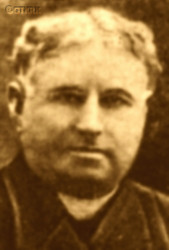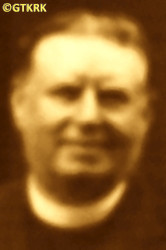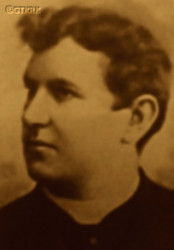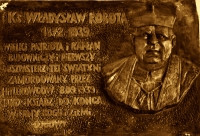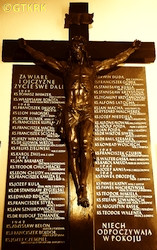Roman Catholic
St Sigismund parish
05-507 Słomczyn
85 Wiślana Str.
Konstancin deanery
Warsaw archdiocese, Poland
full list:
displayClick to display full list

searchClick to search full list by categories
wyświetlKliknij by wyświetlić pełną listę po polsku

szukajKliknij by przeszukać listę wg kategorii po polsku

Martyrology of the clergy — Poland
XX century (1914 – 1989)
personal data
surname
ROBOTA
forename(s)
Vladislav (pl. Władysław)
function
diocesan priest
creed
Latin (Roman Catholic) Church RCmore on
en.wikipedia.org
[access: 2014.09.21]
diocese / province
Katowice diocesemore on
en.wikipedia.org
[access: 2013.05.19]
Apostolic Administration of Upper Silesiamore on
www.catholic-hierarchy.org
[access: 2021.12.19]
Wrocław diocesemore on
en.wikipedia.org
[access: 2013.05.19]
honorary titles
Ad Honores Spiritual Counselor
(c. 1926)
„Medal of Independence”more on
en.wikipedia.org
[access: 2019.02.02]
(20.07.1932)
„Polonia Restituta” Cross — 5th Class, Knight'smore on
en.wikipedia.org
[access: 2019.04.16]
(28.04.1926)
„Star of Upper Silesia” badge
War Order of Virtuti Militari — Silver (5th Class)more on
en.wikipedia.org
[access: 2019.10.13]
„Cross of Valour”more on
en.wikipedia.org
[access: 2019.04.16]
date and place
of death
05.09.1939

Nieborowicetoday: Pilchowice gm., Gliwice pov., Silesia voiv., Poland
more on
en.wikipedia.org
[access: 2022.01.28]
alt. dates and places
of death
06.09.1939, 08.09.1939, 11.09.1939
details of death
During the Prussian rule (of the part of partitioned Poland), persecuted by the German authorities for his pro‐Polish activities. On 01.01.1907, signed — as the parish priest of Gierałtowice, then in the Germ. Kreis Tost–Gleiwitz (Eng. Toszek–Gliwice County), part of the Prussian Germ. Provinz Schlesien (Eng. Province of Silesia) — among 16 Catholic priests, a pre‐election appeal supporing Poles as candidates to the Germ. Preußischer Landtag (Eng. Prussian National Parliament) — elections were held in 1908 — and to the Germ. Reichstag (Eng. Reich Parliament) of the German Empire — elections were held in 1907.
After the abdication on 09.11.1918 of the German Emperor William II Hohenzollern; after the signing on 11.11.1918 by the Allies and the Germans, in a staff wagon in Compiègne, at the headquarters of French Marshal Ferdinand Foch, of an armistice and ceasefire — which de facto meant the end of World War I; and also after the transfer on 11.11.1918 by the Regency Council — operating in the territory occupied by the Central Powers (Germany and Austria–Hungary) of the so‐called Germ. Königreich Polen (Eng. Polish Kingdom) — of supreme command over the army to Brigadier Joseph Piłsudski and appointing him Commander‐in‐Chief of the Polish Army, which de facto meant the rebirth of the Polish state, covering, however, only the Germ. Königreich Polen, i.e. the Polish territory under Russian rule until 1915, and excluding the lands of the Polish lands till then under Prussian rule; the Germ. Kreis Tost–Gleiwitz was still formally part of the German state. Took part then, as one of 431 delegates, in the Polish District Parliament (Seym), which was held on 03‐05.12.1918 in Poznań, and which expressed the will to create a united Polish state with access to the sea, encompassing the Polish lands of the former Prussian partition.
During Prussian rule over part of partitioned Poland harassed by German authorities for Polish activism.
On 01.01.1907, signed, as one of the 16 priests, the pre‐election appeal announcing the appointment of Polish priests as candidates for the Polish Circle in the German parliament.
After the rebirth of the Polish state in 11.1918, elected one of the 431 delegates to the Polish District Parliament, which was held on 03‐05.12.1918 in Poznań, and which expressed will to create a united Polish state with access to the sea, encompassing the Polish lands of the former Prussian partition.
As a result, briefly arrested in 01.1919 by the Germans. Remanded in custody in Gliwice. Released, but for some time went into hiding in a convent in Wrocław.
In 1919‐1921, during preparations for the plebiscite, the convening of which was part of the peace treaty ending World War I, signed on 28.06.1919 in Versailles, and which was to decide on the national affiliation of Upper Silesia and the Opole region, participated in many rallies and meetings in Gliwice and the surrounding towns. The plebiscite, which took place on 20.03.1921, was not beneficial for Poland ‐ for various reasons. Gierałtowice, however, ended up in Poland ‐ as only one of three villages in the Germ. Kreis Tost–Gleiwitz.
During the intensified plebiscite campaign conducted by both thrones, persecuted by German militias. In 1920 survived an assassination attempt.
After German invasion of Poland on 01.09.1939 (Russians invaded Poland 17 days later) and start of the World War II in 09.1939, after start of German occupation, arrested by the Germans after village capture on the first day of war.
Beaten up on the churchyard.
Taken to DL Neubersdorf transit camp in Nieborowice.
During the night of 05‐06.09.1939 German guards got drunk.
They apprehended one of the arrested and started to drag him through all the barracks — any prisoner who agreed to spit on the victim was to be released.
Next all were gathered on the camp's roll–call yard.
The same prisoner, already gravely beaten up was attached to a card and dragged in front of all other prisoners.
Fr Robota apparently protested — and was followed by 16 other prisoners.
All were bunched together and murdered on the spot.
The victims of this „bloody night” were next buried in a local ditch.
The exhumation on 29.09.1946 proved that before death was tortured — the skull was split into seven parts, his ribs and spine were broken.
One of the German witnesses stated: „they jumped on him”.
alt. details of death
According to other sources arrested by the Germans with 14 other Poles on 08.09.1939, taken to an execution site (on the way, was to be beaten and had a jaw knocked out with the rifle butt) and murdered in the forest by the Pilchowice / Nieborowice villages.
cause of death
mass murder
perpetrators
Germans
sites and events
DL NeubersdorfClick to display the description, «Intelligenzaktion»Click to display the description, Ribbentrop‐MolotovClick to display the description, Pius XI's encyclicalsClick to display the description, Silesian UprisingsClick to display the description
date and place
of birth
27.06.1872Birth certification on:
photos.szukajwarchiwach.gov.pl
[access: 2025.08.19]

Gostomiatoday: Biała gm., Prudnik pov., Opole voiv., Poland
more on
en.wikipedia.org
[access: 2022.01.28]
parents
ROBOTA Constantine
🞲 ?, ? — 🕆 ?, ?

SPILLER Susanne
🞲 ?, ? — 🕆 ?, ?
baptism
07.07.1872Birth certification on:
photos.szukajwarchiwach.gov.pl
[access: 2025.08.19]

Gostomiatoday: Biała gm., Prudnik pov., Opole voiv., Poland
more on
en.wikipedia.org
[access: 2022.01.28]
St Guardian Angels RC church
presbyter (holy orders)
ordination
11.06.1898

Wrocławtoday: Wrocław city pov., Lower Silesia voiv., Poland
more on
en.wikipedia.org
[access: 2021.04.02]
St John the Baptist RC archcathedral churchmore on
pl.wikipedia.org
[access: 2021.12.19]
positions held
1934 – 1939
deputy dean — Dębieńskotoday: district of Czerwionka‐Leszczyny, Czerwionka‐Leszczyny gm., Rybnik pov., Silesia voiv., Poland
more on
en.wikipedia.org
[access: 2020.11.27] RC deanery
04.09.1902 – 1939
parish priest — Gierałtowicetoday: Gierałtowice gm., Gliwice pov., Silesia voiv., Poland
more on
en.wikipedia.org
[access: 2022.01.28] ⋄ St Catherine the Virgin and Martyr RC parish (from 1934 Our Lady of the Scapular) ⋄ Dębieńskotoday: district of Czerwionka‐Leszczyny, Czerwionka‐Leszczyny gm., Rybnik pov., Silesia voiv., Poland
more on
en.wikipedia.org
[access: 2020.11.27] RC deanery — builder of the new parish church
1934 – 1939
pro‐synodal judge — Katowicetoday: Katowice city pov., Silesia voiv., Poland
more on
en.wikipedia.org
[access: 2021.08.12] ⋄ Bishop's Diocesan Court ⋄ Katowice RC diocese
1925 – 1939
membership — Katowicetoday: Katowice city pov., Silesia voiv., Poland
more on
en.wikipedia.org
[access: 2021.08.12] ⋄ College of Consultors, Diocesan Curia ⋄ Katowice RC diocese
1923 – 1924
administrator — Knurówtoday: Knurów urban gm., Gliwice pov., Silesia voiv., Poland
more on
en.wikipedia.org
[access: 2022.05.23] ⋄ St Lawrence the Deacon and Martyr RC parish ⋄ Dębieńskotoday: district of Czerwionka‐Leszczyny, Czerwionka‐Leszczyny gm., Rybnik pov., Silesia voiv., Poland
more on
en.wikipedia.org
[access: 2020.11.27] RC deanery — acting („ad interim”)
28.06.1898 – 1902
vicar — Łabędytoday: district of Gliwice, Gliwice city pov., Silesia voiv., Poland
more on
en.wikipedia.org
[access: 2021.04.02] ⋄ Assumption of the Blessed Virgin Mary RC parish ⋄ Gliwicetoday: Gliwice city pov., Silesia voiv., Poland
more on
en.wikipedia.org
[access: 2021.04.02] RC deanery
till 1898
student — Wrocławtoday: Wrocław city pov., Lower Silesia voiv., Poland
more on
en.wikipedia.org
[access: 2021.04.02] ⋄ philosophy and theology, Department of Catholic Theology, University of Wrocław [i.e. University of Wrocław (since 1945) / Frederic Wilhelm University of Silesia (1911‐1945) / Royal University i.e. Breslau Academy (1816‐1911)]
others related
in death
GÓREKClick to display biography Francis, HAROŃSKIClick to display biography Leo Joseph
sites and events
descriptions
DL Neubersdorf: Germ. Durchgangslager (Eng. transit camp), established in 09.1939 by the Germans in Nieborowice for c. 3,000 Polish soldiers, activists and Silesian insurgents, listed on German proscription's lists, which were part of the German «Intelligenzaktion» plan, i.e. the extermination the Polish intelligentsia and leadership classes. Information identifying Polish prisoners was posted on the camp gate: Germ. „Insurgenten — schwarverbrecher” (Eng. „Insurgents — Criminals”), therefore also popularly known as Germ. Afständisches Lager (Eng. insurgents' camp). 2,000 of them died there of subsequently during World War II — some murdered in the camp itself, for instance c. 18 Poles during so‐called „bloody night” of 05‐06.09.1939. The camp was soon dissolved prob. in 09.1939. (more on: pppilchowice.pilchowice.plClick to attempt to display webpage
[access: 2013.08.17])
«Intelligenzaktion»: German: «Intelligenzaktion» (English: „Intelligence Action”) — a German program of extermination of the Polish elite, mainly the intelligentsia and leadership layers, carried out from the beginning of the occupation in w 09.1939 to 04.1940, mainly in territories directly annexed to Germany, but also in the so‐called Germ. Generalgouvernement (Eng. General Governorate), where it was called «AB‐aktion». In the first phase, immediately after the beginning of the German occupation, during military operations carried out by the Germ. Wehrmacht (Eng. Armed Forces) and the genocidal units of the Germ. Einsatzgruppen (Eng. Operational Groups) of the Germ. Sicherheitspolizei (Eng. Security Police), i.e. SiPo, and Germ. Sicherheitsdienst des Reichsführers SS (Eng. Security Service of the Reichsführer SS), i.e. SD, organized by the Germ. Reichssicherheitshauptamt (Eng. Reich Main Security Office), i.e. RSHA, which followed the troops, carried out under the Germ. Unternehmen „Tannenberg” (Eng. Operation „Tannenberg”) — based on the so‐called Germ. Sonderfahndungsliste (Eng. Special Wanted Lists), i.e. proscription lists of Poles considered particularly dangerous to the Third Reich, prepared by the Zentralstelle II/P (Polen) unit of the German RSHA. Later, implemented by the German civilian occupation authorities and the genocidal unit of the Germ. Volksdeutscher Selbstschutz (Eng. Ethnic Germans Self‐Defense), whose members were Germ. Volksdeutsche (Eng. Ethnic Germans), i.e. representatives of the German minority in Poland. According to various sources, these lists, at the beginning of 09.1939, could have contained the details of 61,000—88,000 „dangerous” Poles — although these figures cannot be confirmed. In total, during this genocide, c. 50,000 teachers, Catholic priests, representatives of the landed gentry, freelancers, social and political activists, and retired military personnel were systematically and methodically murdered. Another 50,000 were sent to concentration camps, where only a negligible percentage survived. (more on: en.wikipedia.orgClick to attempt to display webpage
[access: 2014.10.04])
Ribbentrop‐Molotov: Genocidal Russian‐German alliance pact between Russian leader Joseph Stalin and German leader Adolf Hitler signed on 23.08.1939 in Moscow by respective foreign ministers, Mr. Vyacheslav Molotov for Russia and Joachim von Ribbentrop for Germany. The pact sanctioned and was the direct cause of joint Russian and German invasion of Poland and the outbreak of the World War II in 09.1939. In a political sense, the pact was an attempt to restore the status quo ante before 1914, with one exception, namely the „commercial” exchange of the so‐called „Kingdom of Poland”, which in 1914 was part of the Russian Empire, fore Eastern Galicia (today's western Ukraine), in 1914 belonging to the Austro‐Hungarian Empire. Galicia, including Lviv, was to be taken over by the Russians, the „Kingdom of Poland” — under the name of the General Governorate — Germany. The resultant „war was one of the greatest calamities and dramas of humanity in history, for two atheistic and anti‐Christian ideologies — national and international socialism — rejected God and His fifth Decalogue commandment: Thou shall not kill!” (Abp Stanislav Gądecki, 01.09.2019). The decisions taken — backed up by the betrayal of the formal allies of Poland, France and Germany, which on 12.09.1939, at a joint conference in Abbeville, decided not to provide aid to attacked Poland and not to take military action against Germany (a clear breach of treaty obligations with Poland) — were on 28.09.1939 slightly altered and made more precise when a treaty on „German‐Russian boundaries and friendship” was agreed by the same murderous signatories. One of its findings was establishment of spheres of influence in Central and Eastern Europe and in consequence IV partition of Poland. In one of its secret annexes agreed, that: „the Signatories will not tolerate on its respective territories any Polish propaganda that affects the territory of the other Side. On their respective territories they will suppress all such propaganda and inform each other of the measures taken to accomplish it”. The agreements resulted in a series of meeting between two genocidal organization representing both sides — German Gestapo and Russian NKVD when coordination of efforts to exterminate Polish intelligentsia and Polish leading classes (in Germany called «Intelligenzaktion», in Russia took the form of Katyń massacres) where discussed. Resulted in deaths of hundreds of thousands of Polish intelligentsia, including thousands of priests presented here, and tens of millions of ordinary people,. The results of this Russian‐German pact lasted till 1989 and are still in evidence even today. (more on: en.wikipedia.orgClick to attempt to display webpage
[access: 2015.09.30])
Pius XI's encyclicals: Facing the creation of two totalitarian systems in Europe, which seemed to compete with each other, though there were more similarities than contradictions between them, Pope Pius XI issued in 03.1937 (within 5 days) two encyclicals. In the „Mit brennender Sorge” (Eng. „With Burning Concern”) published on 14.03.1938, condemned the national socialism prevailing in Germany. The Pope wrote: „Whoever, following the old Germanic‐pre‐Christian beliefs, puts various impersonal fate in the place of a personal God, denies the wisdom of God and Providence […], whoever exalts earthly values: race or nation, or state, or state system, representatives of state power or other fundamental values of human society, […] and makes them the highest standard of all values, including religious ones, and idolizes them, this one […] is far from true faith in God and from a worldview corresponding to such faith”. On 19.03.1937, published „Divini Redemptoris” (Eng. „Divine Redeemer”), in which criticized Russian communism, dialectical materialism and the class struggle theory. The Pope wrote: „Communism deprives man of freedom, and therefore the spiritual basis of all life norms. It deprives the human person of all his dignity and any moral support with which he could resist the onslaught of blind passions […] This is the new gospel that Bolshevik and godless communism preaches as a message of salvation and redemption of humanity”… Pius XI demanded that the established human law be subjected to the natural law of God , recommended the implementation of the ideal of a Christian state and society, and called on Catholics to resist. Two years later, National Socialist Germany and Communist Russia came together and started World War II. (more on: www.vatican.vaClick to attempt to display webpage
[access: 2023.05.28], www.vatican.vaClick to attempt to display webpage
[access: 2023.05.28])
Silesian Uprisings: Three armed interventions of the Polish population against Germany in 1919‐1921 aiming at incorporation of Upper Silesia and Opole region into Poland, after the revival of the Polish state in 1918. Took place in the context of a plebiscite ordered on the basis of the international treaty of Versailles of 28.06.1919, ending the First World War, that was to decide national fate of the disputed lands. The 1st Uprising took place on 16‐24.08.1919 and broke out spontaneously in response to German terror and repression against the Polish population. Covered mainly Pszczyna and Rybnik counties and part of the main Upper Silesia industrial district. Suppressed by the Germans. 2nd Uprising took place on 19‐25.08.1920 in response to numerous acts of terror of the German side. Covered the entire area of the Upper Silesia industrial district and part of the Rybnik county. As a result Poles obtained better conditions for the campaign prior the plebiscite. The poll was conducted on 20.03.1921. The majority of the population — 59.6% — were in favor of Germany, but the results were influenced by the admission of voting from former inhabitants of Upper Silesia living outside Silesia. As a result the 3rd Uprising broke out, the largest such uprising of the Silesian in the 20th century. It lasted from 02.05.1921 to 05.07.1921. Spread over almost the entire area of Upper Silesia. Two large battles took place in the area of St. Anna Mountain and near Olza. As a result on 12.10.1921 the international plebiscite commission decided on a more favorable for Poland division of Upper Silesia. The territory granted to Poland was enlarged to about ⅓ of the disputed territory. Poland accounted for 50% of metallurgy and 76% of coal mines. (more on: en.wikipedia.orgClick to attempt to display webpage
[access: 2020.05.25])
sources
personal:
encyklo.plClick to attempt to display webpage
[access: 2021.12.19], www.rybnik.plClick to attempt to display webpage
[access: 2013.05.19], www.youtube.comClick to attempt to display webpage
[access: 2021.12.19], photos.szukajwarchiwach.gov.plClick to attempt to display webpage
[access: 2025.08.19], pl.wikipedia.orgClick to attempt to display webpage
[access: 2021.12.19], pl.wikipedia.orgClick to attempt to display webpage
[access: 2013.08.10]
original images:
szkaplerznej.plClick to attempt to display webpage
[access: 2016.05.30], encyklo.plClick to attempt to display webpage
[access: 2021.12.19], szkaplerznej.plClick to attempt to display webpage
[access: 2020.05.25], gieraltowice.archiwa.orgClick to attempt to display webpage
[access: 2016.05.30], jankowice.rybnik.plClick to attempt to display webpage
[access: 2016.05.30], jankowice.rybnik.plClick to attempt to display webpage
[access: 2016.05.30]
LETTER to CUSTODIAN/ADMINISTRATOR
If you have an Email client on your communicator/computer — such as Mozilla Thunderbird, Windows Mail or Microsoft Outlook, described at WikipediaPatrz:
en.wikipedia.org, among others — try the link below, please:
LETTER to CUSTODIAN/ADMINISTRATORClick and try to call your own Email client
If however you do not run such a client or the above link is not active please send an email to the Custodian/Administrator using your account — in your customary email/correspondence engine — at the following address:

giving the following as the subject:
MARTYROLOGY: ROBOTA Vladislav
To return to the biography press below:
 Click to return to biography
Click to return to biography









